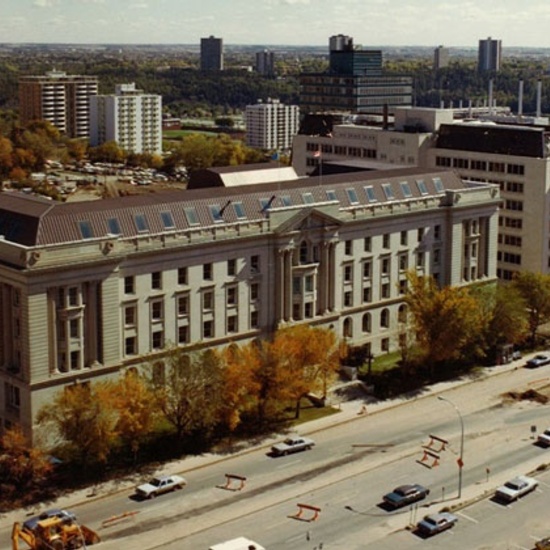Bowker Building
The Bowker Building was the last Edmonton office buildings fashioned in the Beaux-Arts style of architecture.
The Bowker Building was the last Edmonton office buildings fashioned in the Beaux-Arts style of architecture.
When architects Fred H. MacDonald and Cecil S. Burgess designed this building to compliment the Legislature, they fashioned it with elegant Beaux-Arts features. The symmetrical façade includes paired Corinthian columns and frieze, elaborately carved garlands and wreaths, rectangular and semi-circular windows, and a rusticated lower level. A classical cornice and projecting colonnades at each end enhance the balustrade at the roof level. Most impressive is the main entrance on 109th Street. Two short flights of granite steps reach oak doors with bronze grilles. Flanked by fluted columns and capped with a decorated entablature and pediment, this portico is given an Albertan flare with the inclusion of two bison heads, a First Nations chief in ceremonial headdress, and the Albertan coat of arms surmounted by a crown. Visitors enter a large rotunda with a rubber tile floor and ceiling enriched with a moulded cornice, frieze beams, pilaster caps, and a clock in a wood balustrade. The interior halls were terrazzo or rubber tile, while the office floors were laid with maple. The second floor stairwell showcased a stained glass window with a stylized version of the provincial coat of arms, bordered by Alberta’s wild rose.
Constructed by H.G. Macdonald and Company with steel and reinforced concrete, the building is clad in light grey Tyndall dolomite from Garson, Manitoba which accounted for much of the structure’s $940,000 original cost. The building has a depth of 54 feet with wings on either side measuring 42 feet by 54 feet – 87,700 square feet in total. The structure was heated by steam generated from a dedicated underground powerhouse. The Bowker Building was built to alleviate overcrowding at the Legislature building and to accommodate government offices scattered in offsite locations. On its 50th anniversary Woolfenden Group Architect Ltd. were retained to entirely renovate the interior, and yet carefully maintain the historic façades. $7 million were spent on a new roof, new ventilation, a mezzanine, eastern portico, and the addition of a sixth floor made invisible at street level, culminating in the addition of over 50,000 square feet.
Originally called the Administration Building, it was also known as the Natural Resources Building, corresponding to the transference of natural resources to provincial jurisdiction by the federal government in 1931. The building housed the headquarters of the Attorney General’s office and in 1981 it was renamed the Bowker Building in honour of the contributions to the legal profession by Dr. Wilbur Fee Bowker. Bowker was a University of Alberta graduate who practiced law for ten years before enlisting to fight in the Second World War. Upon his return home served 20 years as head of the law faculty at the U. of A. then moved on to head the Alberta Institute of Law Reform, from which he retired in 1975. Throughout his career he was also extensively involved in the community. Upon his death in 1999, his wife Marjorie Bowker (a woman of distinction in the legal profession in her own right) recalled he was known for having “prodigious intellect mixed with compassion”.
Details
Type
Governmental
Designation Status
No Historic Recognition
Neighbourhood
Time Period
Year Built
1931
Architects
Architectural Styles
Character Defining Elements
Balusters , Balustrade , Columns , Concrete Structure , Cornice , Entablature , Flat roof , Parapet , Pediment , Portico , Rectangular footprint , Steel Structure , Stone cladding , Three storeys or more

